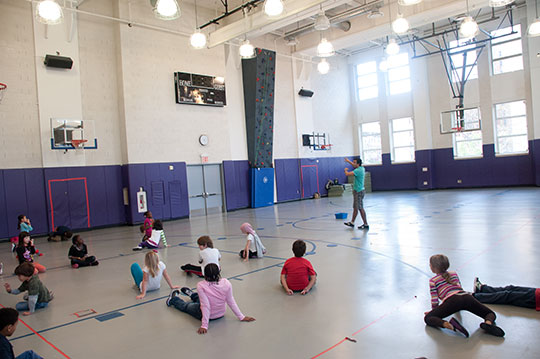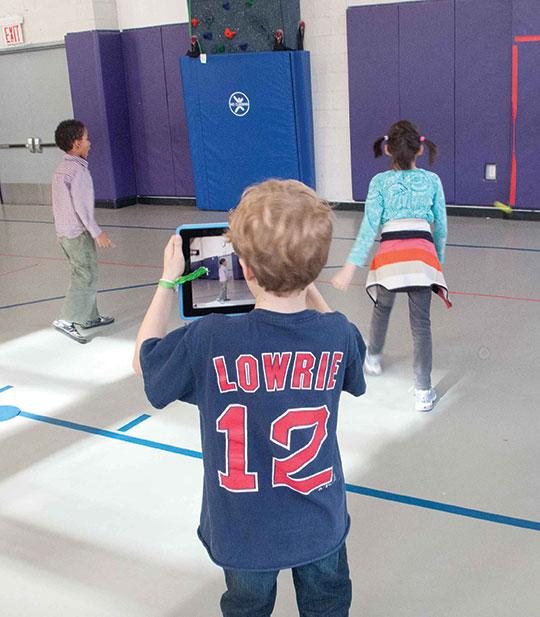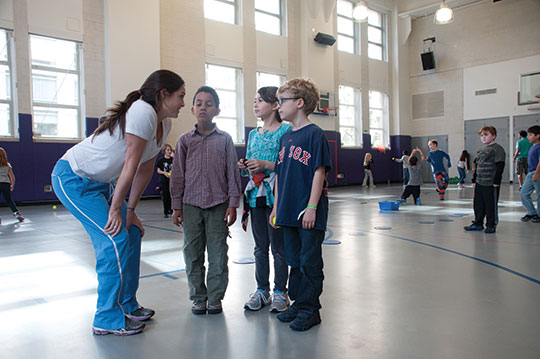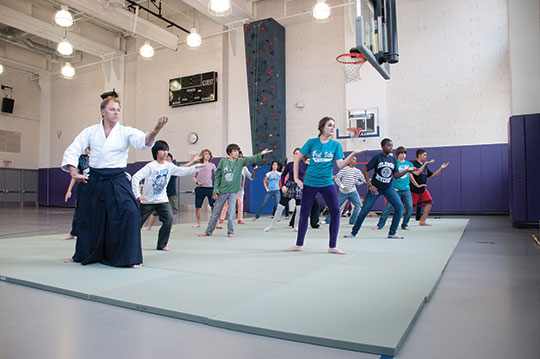Head Games
On a Friday morning in the gym at The School at Columbia University, Doug LeBlanc (M.A., ’01, ’03) has asked his third graders to prepare to exercise their bodies by warming up their minds. In a moment the children will grab jump ropes and work individually, then in small groups, at double Dutch. But first they sit in a circle and discuss how street games came to be invented amid the special conditions of big-city life.
“City” is, in fact, a third-grade curriculum theme across disciplines at The School. The kids call out ideas they’ve studied in the classroom: how jump rope, stickball and other pastimes were the product of limited space and materials; the way buildings and sidewalks substituted for fields. “Street games,” one boy announces seriously, “are traditionally a part of the culture of New York.”
Later, while the kids work in groups across the gym, LeBlanc, their “Wellness” teacher, asks them to photograph one another on their iPads while they jump rope. The images will be used back in the classroom as subject matter for writing time, and possibly on the class blog as well.
Carlos Jamieson, a Teachers College master’s degree student in physical education, looks on. He’s just started his student-teaching placement at The School, leading warm-ups and assisting LeBlanc and his Wellness colleagues, many of whom are also TC graduates. “Is this the first time you’ve seen iPads in a phys ed class?” Jamieson whispers to a fellow observer. “Me, too.”
This tight integration of gym and classroom is part of an emerging teaching approach that proponents hope could revolutionize the physical education (P.E.) field. The new method grows out of research by experts at TC and elsewhere who are discovering connections among attitude, motor skills, knowledge and fitness outcomes. Their findings point P.E. away from the traditional gym class model – competition as motivator; the jocks rule – toward learning, enjoyment and lifelong skills development.
The School champions the new approach, but it has not cast team sports aside. Seventh graders still do a soccer unit, for example, but it’s linked to a teaching theme. The students form a league modeled on the one organized by Nelson Mandela and other prisoners in the Robben Island penitentiary. They write letters arguing for the league’s recognition and demanding equipment, as the prisoners did, and their teachers evaluate their efforts for persuasiveness.
The students study cricket as well, to supplement classes on India and British colonial rule. Along with how to bowl and bat, they learn the sport’s history, rules, scoring and etiquette. “You catch the kids who consider themselves bookish that way,” says Laura Walrath (M.A. ’07), The School’s athletic director, who played Division I soccer in college. “They can teach it to the other kids, and the kids who are better at the physical skills will help them play. You have to reach all types.”
Reaching all types – kids who think of themselves as athletically competent, and others who, for a variety of reasons, do not – is a challenge for every P.E. teacher. Not all choose to address it. The roll-out-the-ball gym class stereotype – where the teacher sets up competitive activities for the most competent students, while others go through the motions, chitchat or just stand around – dies hard.
That’s no surprise, says Walrath’s mentor, Stephen Silverman, who chairs TC’s Department of Biobehavioral Sciences and coordinates the College’s Physical Education program. After all, most P.E. teachers are athletic types themselves.
“One problem is that most of us who were undergraduate P.E. majors were successful doing motor skills, so we’re not thinking about those other kids,” says Silverman, himself a scuba instructor and diving enthusiast. “And those other kids are a lot of the kids, if not most of them.”
Why are so many kids either inhibited about being physically active or else simply unmotivated? Some of the most important reasons originate outside the school setting, beginning with images of physical competence and body standards that pervade society through media and language.
“If you feel your body doesn’t mirror particular dominant ideals, it impacts your physical education engagement,” says Laura Azzarito, Associate Professor of Physical Education, who joined TC’s faculty in 2011. “The body, and learning how to move, matter a great deal to young people, and finding a self that fits and is comfortable in sports, health and physical education can be very difficult for them.”
Gender, race and class affect “embodiment” – how one sees oneself in relation to physical participation and enjoyment -- says Azzarito, who is Italian-born and earned her Ph.D. at Louisiana State University before teaching at Britain’s Loughborough University. In her own research, she says, she has given digital cameras to young people and asked them to create visual diaries to express how they feel in their bodies.
“Many of the boys showed themselves performing sports, very centered in the photos. Many girls were completely absent; they took pictures of other people and never wanted to be in their own photo.”
Research on body perception, while certainly extensive in psychology, is still quite new as applied to physical education, Azzarito says. “With the methods I use, I’m trying, first, to empower young people to tell their own stories about their experiences and struggles in physical activity. Second, I try to assist them in understanding the role of the media in the development of their identities and their bodies. And third, I try to help teachers to see and address inequalities that inform young people’s experiences and physical education.”
All researchers in the field agree that, across cultures, students of both genders lose interest and enthusiasm for P.E. as they get older, particularly around seventh grade, and that the decline is faster and steeper for girls.
That finding, which holds broadly across ethnic groups and regions, came to light thanks to a survey instrument, titled Student Attitude Toward Physical Education, that Steve Silverman codeveloped with Raj Subramaniam, a professor at Ithaca College.
First published in 2000, and based on Subramaniam’s doctoral research, which Silverman supervised when the two were at the University of Illinois, the survey is now widely used in the field. It has produced a wealth of research data, both on overall trends in student attitude and on the attitudinal impact of curriculum and teaching methods.
This research on attitude has helped to substantiate insights that seem intuitively obvious: For example, physical education activities based on competition have an adverse effect on the motivation of kids with lower skills. But it has also supported some unexpected conclusions: For example, de-emphasizing competition doesn’t turn off students with higher skills.
“Sometimes P.E. teachers will say to me, ‘If I do what you suggest, the high-skills kids will get bored,’” Silverman says. “But our research suggests there’s nothing they can do to mess up the high-skills kids. That’s not the problem we have in kids learning and enjoying P.E.”
In fact, the really good news from the new attitude research is that skill level, high or low, is not the defining factor in whether students engage in and benefit from physical education. What really tips the scales, so to speak, is the quality of instruction; there is no inherent reason why a less athletic student would be less likely to enjoy P.E. “We found that the teacher and the curriculum were the primary factors that affected attitude,” Subramaniam says.
Jennifer Rasmussen (Ed.D. ’06), a lecturer who coordinates TC’s master’s degree program in physical education and supervises student field placements, calls that finding “breakthrough stuff” because it changes the goals of P.E.
“Now teachers have to design their lessons to target the low-skilled and the advanced,” Rasmussen says. “So what are you going to do? What modifications are you going to make as an educator so that everybody is learning within their activity and at their own pace?”
The integrated curriculum at The School at Columbia University offers one answer: giving students the historical or political context about different sports (e.g., colonialism as a backdrop for cricket) to lend physical activity greater meaning. The School also employs the Sport Education Model, an approach to teaching team sports that rotates students through all the relevant roles – player, coach, referee, scorekeeper, equipment manager – so that everyone’s involved.
But it’s equally important to tailor physical activities as closely as possible to individual skill levels, so that students are motivated to rise to challenges instead of avoiding them. And that, says Silverman, would ideally mean taking the most radical step of all: dropping team sports entirely from physical education classes.
“With team sports, not everyone is playing, and so they’re not learning,” he says. “And the teachers can’t possibly spend enough time with them.”
Instead, Silverman says, students should work to achieve personal targets through individual and small-group activities, enabling teachers to roam the gym offering individualized instruction. Or to put it another way: Forget the old-fashioned gym teacher, barking out commands. Instead, think yoga instructor or personal trainer.
Back at The School, Walrath operates in precisely this fashion with a group of seventh graders who are working on a fitness unit, practicing curl-ups and push-ups. She moves from pair to pair, gives tips on form, offers encouragement and stops to work more closely with a few students who need help.
In the end, Silverman says, teachers must play the key role in making physical education effective and enjoyable for all students. There’s no question that at an independent institution like The School, which is blessed with curricular freedom and resources, the teachers are more likely to accept the hours and workload that interdisciplinary teaching entails. But Silverman hopes that as the new gospel spreads, newer teachers coming up are going to get on board.
“It boils down to whether the teachers want to do it,” he says. “Where there are a lot of young teachers together, you tend to see changes happening.”
Published Friday, Dec. 7, 2012



